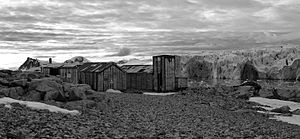Stonington Island
| Stonington Island | ||
|---|---|---|
| East Base of the United States Antarctic Service on Stonington Island | ||
| Waters | Marguerite Bay | |
| Geographical location | 68 ° 11 ′ 7 ″ S , 66 ° 59 ′ 49 ″ W | |
|
|
||
| length | 770 m | |
| width | 390 m | |
| surface | 20 ha | |
| Highest elevation |
Anemometer Hill 25 m |
|
The Stonington Island is a rocky island , which the 1.5 km north-east Neny Island in the eastern part of Marguerite Bay off the Fallières coast of Graham Lands on the Antarctic Peninsula is located. It is around 650 × 320 m in size and was connected to the Northeast Glacier on the mainland by a snow bridge until the 1970s . At the same point there is now 400 meters of open sea to the edge of the glacier.
The island was chosen as the location for the eastern base camp ( East Base ) of the United States Antarctic Service Expedition (1939-1941). The East Base was built in the north of the island and offered space for 26 people. In 1941 the station was abandoned because of the US entry into World War II. On February 24, 1946, Great Britain took the station Stonington Island (Base E) with two buildings for 11 people in the central part of the island in operation, continuously until February 12, 1950, then still temporarily in 1958/59 and 1963-1966. The two former research stations are now among the protected historical sites and monuments in the Antarctic as HSM-55 and HSM-64.
The island is also one of the Important Bird Areas in Antarctica (IBA Ant001). It is the breeding area of the blue-eyed shark , the Antarctic skua and the Antipodean tern .
It is named after the city of Stonington in the US state of Connecticut , home port of the Sloop Hero , with whom Nathaniel Palmer succeeded in sighting the Antarctic continent on November 17, 1820.
literature
Web links
- Stonington Iceland in the Geographic Names Information System of the United States Geological Survey (English)
- Stonington Island on geographic.org (English)
Individual evidence
- ^ Harris CM, Carr R., Lorenz K. and Jones S .: Important Bird Areas in Antarctica - Antarctic Peninsula, South Shetland Islands, South Orkney Islands. Prepared for BirdLife International and the Polar Regions Unit of the UK Foreign & Commonwealth Office. Environmental Research & Assessment Ltd., Cambridge, 2011, p. 100 (English).

